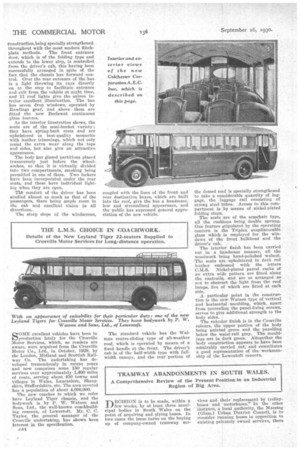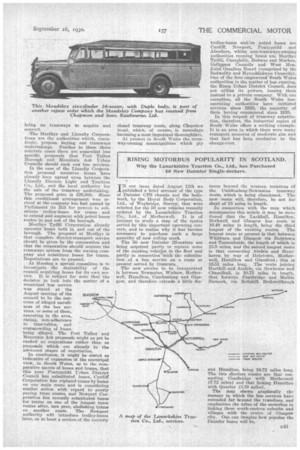TRAMWAY ABANDONMENTS IN SOUTH WALES.
Page 66

Page 67

If you've noticed an error in this article please click here to report it so we can fix it.
A Comprehensive Review of the Present Position in an Industrial Region of Big Area.
ECTSION is to be made, within a 1-1 few weeks, by at least three munfcipal bodies in South Wales on the point of acquiring and plying buses. In two cases the issue turns on the buying up of company-owned tramway ser
vices. and their replacement by trolleybuses and motorbuSes7 In the other instance, a local authority, the Maesteg (Glam.) Urban District Council, is to consider running buses in opposition to existing privately • owned services, there
eAsriow
rati. srarr I
beina no tramways to acquire and convert.
The Merthyr and Llanelly Corporations are the authorities which, tentafively, propose buying out tramways undertakings. Further to these three concrete eases there are somewhat less specific proposals that Port Talbot Borough and Mbuntain Ash Urban Councils should each .run bus services.
In the case of the Llanelly Corporation .proposal tentative • terms have Llauelly Electric Light and Traction already been agreed upon between the Co., Ltd., and the local authority for the sale of the tramway undertaking. The proposed price is 126,000. Since this conditional arrangement was attired at the company has bad passed by Parliament its Bill for powers to substitute trolley-buses for trams and to extend and augment with petrol buses routes in and out of the borough.
Merthyr Tydfil Corporation already operates buses both in and out of the borough. The proposal at Merthyr is that complete district-transport service should be -given by the cernoration and that the corporation should acquire the tramways system from the owning company and substitute buses for trams. Negotiations are to proceed.
At MaeSteg a special committee is to investigate the desirability of the council acquiring -buses for its own service. It is subject for note that the decision to look into the matter of a municipal bus service was stated at the August meeting of the council to he the out
come of alleged unruli.C401.1014 ness of the bus serFLAGS
vices, or some of them, operating in the area, racing, non-adherence to time-tables, and oversrowding of buses being alleged. The Port Talbot and Mountain Ash proposals might as yet be ranked as suggestions rather than as proposals which are already in the advanced stages cif negotiation.
In conclusion, it might be stated as indicative of expansion of the municipal view, in South Wales, as to the comparative merits of buses and trams, that this year Pontypridd Urban District Council has substituted buses, Cardiff Corporation has replaced trams by buses on one main route and, is considering similar action with regard to poorly paying tram routes, and Newport Corporation has recently substituted Naos for trams on one of the longest town routes after, last year, abolishing trains on another route. The Newport authority will introduce trolley-buses later, on at least a section of the recently
closed tramway route, along Chepstow 'Road, which, of course, is nowadays becoming a most important thoroughfare.
At present in South Wales the tramway-owning municipalities which ply trolley-buses and/or petrol buses are Cardiff, Newport, Pontypridd and Aberdare, whilst non-tramways-owning authorities running buses are Merthyr Tydfil, Caerphilly, Bedwas and Machen. Gellygaer Councils and West Mon. Joint Omnibus Board (comprised by the Bedwellty and Mynyddislwyn Councils). One of the first empowered South Wales authorities in the matter of bus running, the Risca Urban District Council, does not utilize its powers, leasing them instead to a private company. With one exception, all the South Wales busoperating authorities have initiated services since 1920, the majority of them having commenced since 1925.
In this respect of tramway substitution, therefore, the industrial region of South Walesoffers a striking example. It is an area in which these were many transport concerns of moderate size and that fact has been conducive to the change-over.












































































































